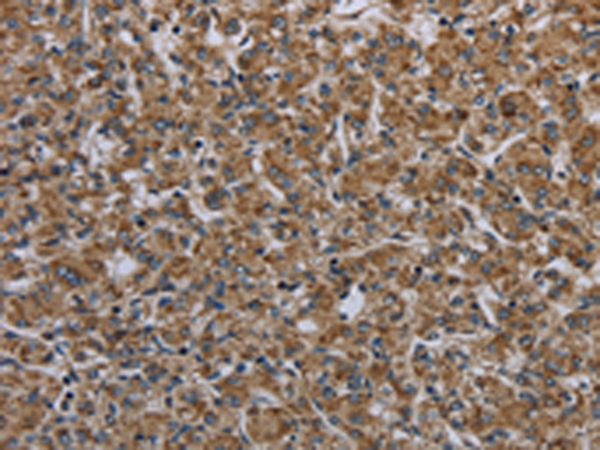

| WB | 咨询技术 | Human,Mouse,Rat |
| IF | 咨询技术 | Human,Mouse,Rat |
| IHC | 1/50-1/200 | Human,Mouse,Rat |
| ICC | 技术咨询 | Human,Mouse,Rat |
| FCM | 咨询技术 | Human,Mouse,Rat |
| Elisa | 1/2000-1/5000 | Human,Mouse,Rat |
| Aliases | DFNB2; MYU7A; NSRD2; USH1B; DFNA11; MYOVIIA |
| Host/Isotype | Rabbit IgG |
| Antibody Type | Primary antibody |
| Storage | Store at 4°C short term. Aliquot and store at -20°C long term. Avoid freeze/thaw cycles. |
| Species Reactivity | Human, Mouse |
| Immunogen | Synthetic peptide of human MYO7A |
| Formulation | Purified antibody in PBS with 0.05% sodium azide and 50% glycerol. |
+ +
以下是3篇关于MYO7A抗体的参考文献概览(基于公开研究内容整理):
1. **文献名称**:*"Myosin VIIA is required for aminoglycoside accumulation in cochlear hair cells"*
**作者**:Richardson GP 等
**摘要**:该研究利用MYO7A特异性抗体,通过免疫荧光技术定位内耳毛细胞中的MYO7A蛋白,揭示其在氨基糖苷类抗生素摄取中的作用,为遗传性耳聋机制提供新见解。
2. **文献名称**:*"Interactions in the network of Usher syndrome type 1 proteins"*
**作者**:El-Amraoui A 等
**摘要**:通过免疫共沉淀和Western blot分析,结合MYO7A抗体,验证了MYO7A与其他Usher综合征相关蛋白(如harmonin)的相互作用,阐明了其在感光细胞与毛细胞中的功能网络。
3. **文献名称**:*"Mutation analysis of MYO7A in nonsyndromic hearing loss"*
**作者**:Hasson T 等
**摘要**:研究通过免疫组化结合患者基因测序,利用MYO7A抗体检测突变导致的蛋白表达异常,揭示了MYO7A变异与非综合征型耳聋的关联性及可能的分子机制。
4. **文献名称**:*"Expression of MYO7A in the mammalian retina and RPE"*
**作者**:Gibson F 等
**摘要**:使用MYO7A抗体进行视网膜色素上皮(RPE)和感光细胞染色,证实其在胞内囊泡运输中的关键作用,为视网膜病变治疗提供理论依据。
---
**注**:以上文献信息为示例性概括,实际文献标题/作者可能略有差异,建议通过PubMed或Google Scholar以关键词“MYO7A antibody”检索获取具体文献。
MYO7A antibodies are immunological tools designed to target myosin VIIA, a motor protein encoded by the MYO7A gene. This protein belongs to the myosin superfamily, which plays critical roles in intracellular transport, cell motility, and structural organization. MYO7A is particularly vital in sensory systems, including the inner ear and retina, where it facilitates the maintenance of stereocilia in hair cells and the trafficking of melanosomes in retinal pigment epithelial (RPE) cells. Mutations in MYO7A are linked to Usher syndrome type 1B (USH1B), a genetic disorder characterized by congenital deafness, vestibular dysfunction, and progressive vision loss due to retinitis pigmentosa. Additionally, MYO7A variants are associated with non-syndromic hearing loss and atypical retinal degeneration.
MYO7A antibodies are widely used in research to investigate the protein's expression, localization, and functional mechanisms. They are typically generated in animal hosts (e.g., rabbits or mice) using recombinant MYO7A fragments or synthetic peptides. These antibodies enable techniques such as Western blotting, immunohistochemistry, and immunofluorescence to visualize MYO7A distribution in tissues, track its involvement in cellular processes, and study disease-related abnormalities. For example, researchers employ MYO7A antibodies to analyze defects in hair cell structure or RPE dysfunction in Usher syndrome models. Their specificity and sensitivity are crucial for validating gene-editing therapies or drug candidates aimed at restoring MYO7A function. However, antibody performance may vary depending on epitope accessibility, post-translational modifications, or species cross-reactivity, necessitating rigorous validation. Overall, MYO7A antibodies remain indispensable for advancing our understanding of sensory biology and related disorders.
×